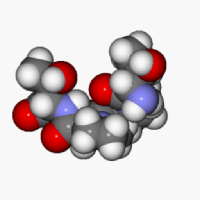Rapastinel
 | |
 | |
| Clinical data | |
|---|---|
| Pregnancy category |
|
| ATC code | none |
| Legal status | |
| Legal status |
|
| Identifiers | |
| |
| CAS Number | 117928-94-6 |
| PubChem (CID) | 14539800 |
| ChemSpider | 25069944 |
| Chemical and physical data | |
| Formula | C18H31N5O6 |
| Molar mass | 413.47 g/mol |
| 3D model (Jmol) | Interactive image |
| |
| |
Rapastinel (INN) (former developmental code names GLYX-13, BV-102) is a novel antidepressant that is under development by Allergan (previously Naurex) as an adjunctive therapy for the treatment of treatment-resistant major depressive disorder.[1][2] It is a centrally active, intravenously administered (non-orally active) amidated tetrapeptide (Thr-Pro-Pro-Thr-NH2) that acts as a selective, weak partial agonist (mixed antagonist/agonist) of an allosteric site of the glycine site of the NMDA receptor complex (Emax ≈ 25%).[1][2] The drug is a rapid-acting and long-lasting antidepressant as well as robust cognitive enhancer by virtue of its ability to both inhibit and enhance NMDA receptor-mediated signal transduction.[1][2]
On March 3, 2014, the U.S. FDA granted Fast Track designation to the development of rapastinel as an adjunctive therapy in treatment-resistant major depressive disorder.[3] As of 2015, the drug had completed phase II clinical development for this indication.[4] On January 29, 2016, Allergan (who acquired Naurex in July 2015) announced that rapastinel had received Breakthrough Therapy designation from the U.S. FDA for adjunctive treatment of major depressive disorder.
Rapastinel belongs to a group of compounds, referred to as glyxins (hence the original developmental code name of rapastinel, GLYX-13),[5] that were derived via structural modification of B6B21, a monoclonal antibody that similarly binds to and modulates the NMDA receptor.[2][6][7] The glyxins were invented by Joseph Moskal, the co-founder of Naurex.[5] Glyxins and B6B21 do not bind to the glycine site of the NMDA receptor but rather to a different regulatory site on the NMDA receptor complex that serves to allosterically modulate the glycine site.[8] As such, rapastinel is technically an allosteric modulator of the glycine site of the NMDA receptor, and hence is more accurately described as a functional glycine site weak partial agonist.[8]
In addition to its antidepressant effects, rapastinel has been shown to enhance memory and learning in both young adult and learning-impaired, aging rat models.[9] It has been shown to increase Schaffer collateral-CA1 long-term potentiation in vitro. In concert with a learning task, rapastinel has also been shown to elevate gene expression of hippocampal NR1, a subunit of the NMDA receptor, in three-month-old rats.[10] Neuroprotective effects have also been demonstrated in Mongolian Gerbils by delaying the death of CA1, CA3, and dentate gyrus pyramidal neurons under glucose and oxygen-deprived conditions.[11] Additionally, rapastinel has demonstrated antinociceptive activity, which is of particular interest, as both competitive and noncompetitive NMDA receptor antagonists are ataxic at analgesic doses, while rapastinel and other glycine subunit ligands are able to elicit analgesia at non-ataxic doses.[12]
See also
- 4-Chlorokynurenine (AV-101)
- Apimostinel (NRX-1074)
- Buprenorphine/samidorphan (ALKS-5461)
- CERC-301
- Dextromethorphan/quinidine (AVP-786/AVP-923)
- Esketamine
- Ketamine
- Neboglamine (nebostinel)
- NSI-189
References
- 1 2 3 Hashimoto K, Malchow B, Falkai P, Schmitt A (August 2013). "Glutamate modulators as potential therapeutic drugs in schizophrenia and affective disorders". Eur Arch Psychiatry Clin Neurosci. 263 (5): 367–77. doi:10.1007/s00406-013-0399-y. PMID 23455590.
- 1 2 3 4 Moskal JR, Burgdorf JS, Stanton PK, Kroes RA, Disterhoft JF, Burch RM, Amin Khan M (2016). "The Development of Rapastinel (Formerly GLYX-13); a rapid acting and long lasting antidepressant". Curr Neuropharmacol. PMID 26997507.
- ↑ FDA Grants Fast Track Designation to Naurex's Rapid-Acting Novel Antidepressant GLYX-13 http://www.prnewswire.com/news-releases/fda-grants-fast-track-designation-to-naurexs-rapid-acting-novel-antidepressant-glyx-13-248174561.html
- ↑ http://naurex.com/wp-content/uploads/2014/12/Naurex_P2b_Data_Press_Release_FINAL_Approved.pdf
- 1 2 Burgdorf, Jeffrey; Zhang, Xiao-lei; Weiss, Craig; Matthews, Elizabeth; Disterhoft, John F.; Stanton, Patric K.; Moskal, Joseph R. (2011). "The N-methyl-d-aspartate receptor modulator GLYX-13 enhances learning and memory, in young adult and learning impaired aging rats". Neurobiology of Aging. 32 (4): 698–706. doi:10.1016/j.neurobiolaging.2009.04.012. ISSN 0197-4580.
- ↑ Haring R, Stanton PK, Scheideler MA, Moskal JR (1991). "Glycine-like modulation of N-methyl-D-aspartate receptors by a monoclonal antibody that enhances long-term potentiation". J. Neurochem. 57 (1): 323–32. doi:10.1111/j.1471-4159.1991.tb02131.x. PMID 1828831.
- ↑ Moskal JR, Kuo AG, Weiss C, Wood PL, O'Connor Hanson A, Kelso S, Harris RB, Disterhoft JF (2005). "GLYX-13: a monoclonal antibody-derived peptide that acts as an N-methyl-D-aspartate receptor modulator". Neuropharmacology. 49 (7): 1077–87. doi:10.1016/j.neuropharm.2005.06.006. PMID 16051282.
- 1 2 Burch RM, Amin Khan M, Houck D, Yu W, Burgdorf J, Moskal JR (2016). "NMDA Receptor Glycine Site Modulators as Therapeutics for Depression: Rapastinel has Antidepressant Activity without Causing Psychotomimetic Side Effects". Curr Neuropharmacol. PMID 26830963.
- ↑ Burgdorf, Jeffrey; Zhang, Xiao-lei; Weiss, Craig; Matthews, Elizabeth; Disterhoft, John F.; Stanton, Patric K.; Moskal, Joseph R. (2011). "The N-methyl-d-aspartate receptor modulator GLYX-13 enhances learning and memory, in young adult and learning impaired aging rats". Neurobiology of Aging. 32 (4): 698–706. doi:10.1016/j.neurobiolaging.2009.04.012. PMC 3035742
 . PMID 19446371.
. PMID 19446371. - ↑ Moskal, Joseph R.; Kuo, Amy G.; Weiss, Craig; Wood, Paul L.; O'Connor Hanson, Amy; Kelso, Stephen; Harris, Robert B.; Disterhoft, John F. (2005). "GLYX-13: A monoclonal antibody-derived peptide that acts as an N-methyl-d-aspartate receptor modulator". Neuropharmacology. 49 (7): 1077–87. doi:10.1016/j.neuropharm.2005.06.006. PMID 16051282.
- ↑ Stanton, Patric K.; Potter, Pamela E.; Aguilar, Jennifer; Decandia, Maria; Moskal, Joseph R. (2009). "Neuroprotection by a novel NMDAR functional glycine site partial agonist, GLYX-13". NeuroReport. 20 (13): 1193–7. doi:10.1097/WNR.0b013e32832f5130. PMID 19623090.
- ↑ Wood, Paul L.; Mahmood, Siddique A.; Moskal, Joseph R. (2008). "Antinociceptive action of GLYX-13: An N-methyl-D-aspartate receptor glycine site partial agonist". NeuroReport. 19 (10): 1059–61. doi:10.1097/WNR.0b013e32830435c9. PMID 18580579.
External links
- Rapastinel (GLYX-13) - Naurex, Inc.
- Rapastinel Receives FDA Breakthrough Therapy Designation - Allergan plc. press release